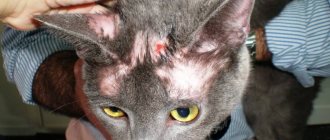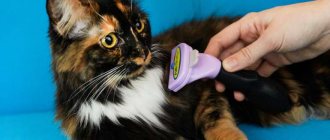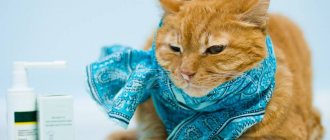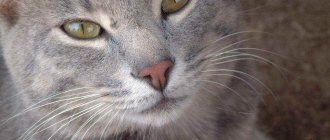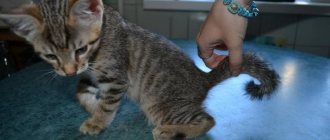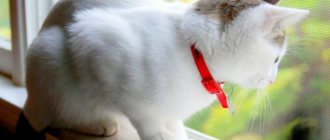To remove fleas from cats and prevent their occurrence, it is necessary to observe and maintain cleanliness in the room. Constant disinfestation of floors, as well as the animal’s habitat and objects with which it comes into contact (bedding, carriers) helps against insects. Treatment is based on the choice of flea remedies: shampoos, drops, collars, injections. The process of getting rid of it is not difficult, but it requires patience and consistency in actions.
What to do if your cat has fleas
Removing fleas from cats at home is a doable task, the main thing is to follow all the rules so as not to repeat the procedure from the beginning. To get rid of pests you need to:
- Treat the animal's fur with special products, and after a few days comb it out to remove larvae and dead insects.
- Buy a flea collar or tablets to help prevent the appearance of parasites. For preventive purposes, check the fur for fleas and comb it thoroughly. Bath periodically using shampoos to prevent the spread of insects.
- Check your pet's bedding and treat with anti-flea medications. The smell of pine needles repels insects; you can fill a cat's bed with it.
- Wash the floors, vacuum upholstered furniture and inspect all hard-to-reach places where fleas could hide. To prevent the growth of pests, use special products to treat all surfaces (herbal infusions, whitewash, soda and salt solutions).
- Use a household hair dryer to treat areas where egg laying is possible. Wash and iron bed linen and clothes.
- Avoid contact with infected animals.
Also read the article about fleas in cats, cats and kittens.
Which disinfectant to choose
How to remove fleas with an antiparasitic agent, which drug should be preferred? Previously, housewives used exclusively “Dichlorvos”, but it is almost impossible to find it in the original version. The active component dimethyldichlorovinylphosphate has long been replaced by more effective and, importantly, safe substances - pyrethroids.
The latest generation of preparations contain synthetic and natural insecticides and do not have a specific odor.
Carefully study the composition, it should contain the following elements (ideally there should be several insecticides, since fleas may develop resistance to a certain component):
- Pyrethrin (pyrethrum) is a component of Dalmatian chamomile.
- Tetramethrin, talstar, cypermethrin, deltamethrin are synthetic analogues of pyrethrin.
- Fipronil - most often used to remove parasites from cats and dogs.
- Benzyl benzoate is also used to remove lice.
- Piperonyl butoxide is often present in combination with permethrin.
Preparations such as Dichlorvos and Karbofos, although relatively inexpensive, are today used only for treating non-residential or industrial premises.
Disinfection preparations are available in various forms:
- concentrates that need to be diluted in water;
- aerosols and sprays in cylinders;
- pencils, dusts, insecticidal powders.
INTERESTING TO KNOW: What to do if bitten by a cat
Household chemicals experts say that concentrates are the most effective in fighting fleas, and they have another advantage - an affordable price. Using just 1 bottle of concentrate, you can treat a large area. Disadvantages include toxicity and unpleasant odor. The most popular concentrates are Cucaracha, Executioner, Agran, Tetrix, Tsifoks.
But concentrated microcapsule insecticides, produced in the form of suspensions, are practically odorless (Get, Zone).
Before use, the concentrates are diluted in water according to the instructions, after which the solution is poured into a regular spray bottle and sprayed throughout the apartment. The principle of operation is the same as that of the spray.
Ready-made aerosols are more convenient to use, flavored, practically safe to use and give good results. The disadvantage is the high price. Combat, Raptor, and Raid are considered the most effective.
Pencils and insecticidal dusts do not give as good a result as concentrates and aerosols, moreover, they are toxic and are more aimed at destroying larvae than adults, which feed on nothing but blood. It is rational to use dusts in non-residential premises - attics, verandas, cellars. Phenaxin and Clean House have proven themselves to be excellent. The advantage of such drugs is their reasonable cost.
Under no circumstances should you treat your cat with a product that is used to clean an apartment, otherwise the animal will suffer severe toxic poisoning and serious side effects.
The room can be re-treated after two weeks, since after one use of the antiparasitic agent, all fleas will not die.
If we talk about self-treatment of premises against fleas, then even if there is a very large premises, the financial issue is resolved within 1,500 rubles. But the disadvantage of such an event is the labor intensity and the possibility of oversights, thanks to which some individuals can safely avoid the effects of the antiparasitic drug.
A much more reliable way is to call a team of exterminators to your home, who not only know how to treat the apartment professionally, but will also give a guarantee for several months.
Effective remedies for getting rid of fleas in cats
There are several types of products that can help you deal with pests yourself. However, before starting treatment, you should consult your veterinarian. Depending on the degree of damage, a specific type of flea medication is selected. In addition, before processing, you must read the instructions, since the wrong dosage can lead to poisoning of the cat.
There are also contraindications to the use of anti-flea drugs:
- second half of pregnancy;
- nursing cats;
- kittens up to 3 months;
- sick or weakened pets;
- intolerance to components.
Anti-flea shampoos
They are easy to use and safe for kittens and pregnant cats as they are non-toxic. Also suitable for long-haired breeds. The composition contains insecticides that kill adult fleas and their larvae. Extracts of medicinal herbs with an anti-inflammatory effect are also added to shampoos to cope with itching after bites. The only drawback of this method is a cat that does not like to bathe. The process in this case will be long.
The following brands of shampoos are in great demand:
- Phytoelite;
- Leopard;
- Lugovoy;
- Celandine;
- Insectin;
- Deluxe.
Drops on the withers
You can get rid of fleas using drops that contain active substances: ivermectin, permethrin, fipronil and others.
The product should be applied to the animal’s withers or along the spine, but so that the cat cannot lick the product. The drops have an accumulating effect, so the protection will last longer, unlike other means.
Before starting use, you must read the instructions, which indicate the rules for applying the drug:
- You should calculate the required dosage; for this you will need to weigh the cat.
- Before use, the pet must be combed.
- The animal's skin must be dry and the fur must be parted to apply the drops.
- For 48 hours, avoid contact with children and other animals, and do not bathe the cat.
The following are considered proven anti-flea drops:
- Frontline;
- Advocate;
- Leopard;
- Celandine;
- Dana-2 Ultra.
The products have contraindications that you should familiarize yourself with; many are not suitable for nursing, weakened or pregnant cats.
Anti-flea collars
Preference is given to collars if the cat often visits the street. This method of protection helps fight not only fleas, but also ticks. The collars are impregnated with the same composition as the drops; it penetrates the skin, so when a cat bites, the fleas die.
Another advantage is their long-term protection and ease of use. Many manufacturers guarantee protection for a period of 3 to 8 months. However, the product has no effect on the larvae and eggs of parasites; in this case, the owners resort to two treatment methods simultaneously. In this case, you should first consult with a veterinarian, otherwise overdose and poisoning are possible.
The most effective anti-flea collars are:
- Harts;
- Bolfo;
- Diaz..
Flea sprays
Aerosols are suitable not only for treating the pet itself, but also its bedding and habitat. The advantage of this product is ease of use and fast action.
Before starting treatment, you should choose a ventilated place, preferably a balcony or go outside. Spray at a distance of 30 cm from the cat. The instructions may indicate that after half an hour the animal should be combed and the drug should be washed off. Since the product is toxic, you should not allow your cat to lick itself.
Effective sprays are:
- Frontline;
- Harts;
- Leopard;
- Bolfo-Aerosol;
- Deluxe.
Insect injections
This method has a number of contraindications, and it should be used under the supervision of a specialist. More often, injections are used for severe insect infestation, and the duration of the effect is about 6 months.
Preparations for injections:
- Ivermectin;
- Eprimek;
- Lufenuron.
Tablets against blood-sucking insects
Suitable if the animal develops dermatitis and external use of the products is impossible. The drugs are fast-acting; after administration, the parasites die within 30 minutes. These include:
- Comfortis;
- Lufenuron;
- Milbemax.
However, this method can cause an allergic reaction in the cat, so treatment should be carried out under the supervision of a veterinarian.
Methods and means of controlling parasites
When starting to eliminate fleas from a cat, you should remember that the animal will definitely lick itself, which automatically transfers the product used from the category of external influence to a preparation for oral administration. If you allow anti-flea substances to enter your digestive system, symptoms of poisoning will certainly appear.
Fleas on a cat cannot be eliminated with simple soap or shampoo. This is only possible in humans and hairless animals. For example, a hairless cat has a better chance of getting by with little effort in exterminating fleas. It may be enough to use only detergent shampoo here. After all, fleas don’t grow on humans! And all because he has no fur and washes himself often.
Of course, you can wash your cat only with regular shampoo or soap. In this case, some of the fleas will be washed away with water. But you can’t just take the main colony of these stubborn insects. While you are bathing your shaggy pet, nimble fleas hide in the most secluded corners of the hair, cling to the skin and fur and survive this soapy tsunami.
In order for the parasites to suffocate, it is necessary for the flea-infested cat or kitten to wash continuously for 2 hours. At the same time, their bodies must be in water all the time.
Review of popular tools
So what to do, how to rid your pet of bloodsuckers quickly and for a long time? There are the following measures to control parasites:
Drops on the withers
Such as: Hartz, Frontline or Bars. This placement of the medicine is associated with two points: cats’ fleas are most often located in the front part of the body, and the cat itself will not be able to lick the scruff of the neck. These products are usually expensive, but are highly effective.
Special anti-flea shampoos
For example: Fitoelita, Barsik, Lugovoy and Rolf-Club. Such preparations should be used immediately as soon as at least one flea appears on the cat’s body. The sooner you start treating, the faster the animal will be cured. It is especially recommended to use shampoos to treat kittens. Usually one treatment is enough. However, if there are a lot of fleas and the cat has freedom of movement, a repeat procedure becomes necessary. It is best to wash the cat again 5 days after the initial treatment.
Various specialized sprays
For example, Barsik, Hartz, Advantage, Beaphar. The advantages of such products are ease of application: quickly and without pain for the cat and its owner. Some of them, such as Beaphar, have a mint scent. It is not known whether the cat likes it, but people definitely like it.
The disadvantage of this product is its short period of action and shallow penetration under the fur. Most products with this method of application allow you to get rid of fleas only at the very moment of applying the product to the fur.
Collars
Collars treated with special insecticides. These substances act not only in the area of the collar itself, but also repel pests from the entire cat's body. However, this product can only be used for adult and healthy cats.
What to do after treatment?
You need to lather the entire body with medicated shampoo generously. If there are a lot of external parasites, they often flee from the treated area to something that is still dry and safe. So that the fugitives have nowhere to hide, it is better to handle the cat from head to tail. Moreover, it is better to wet the body with water in the same sequence. When the animal’s soaping is finished, it must be placed in water up to its chest and the soap suds must also be gradually washed off. In this case, the enemy will have nowhere to retreat.
Fighting bloodsuckers at home also includes regular wet cleaning: fleas and their larvae are afraid of water.
Rinse the shampoo thoroughly with several waters. Don't forget that cats will lick their bodies in disgust and indignation in the hope of restoring that wonderful cat scent.
By the way, as a preventive measure, if there is a threat of infection, the cat can be treated with tar soap about 2 times a month. Insects generally do not like the smell of this substance, and fleas are no exception.
Video: Fleas on a cat, preventive methods
Folk remedies for fleas in cats
Turning to unconventional methods makes sense with a small flea infestation and in cases of:
- animal pregnancy;
- cat hypersensitivity to drug components;
- pet illness, in which anti-flea drugs can aggravate the condition;
- presence of a kitten in the house.
A few recipes to help get rid of pests:
- Floral cologne, 3% vinegar, camphor alcohol. Take the ingredients in equal proportions, pour into a container and spray on the cat’s fur. Then put the bag on the animal, so that the head remains outside, and leave for 10 minutes. Then comb the cat.
- Homemade anti-flea shampoo. Rub ¼ baby soap and pour boiling water over it. Cook over low heat until jelly-like. Cool and add chopped onion, yolk and 1 tsp. decoction of calendula. Lather the animal with the resulting mixture and leave for 20 minutes, then rinse and dry thoroughly.
- Wormwood decoction. Take 1 tbsp. l. dry and fresh herbs, pour 300 ml of boiling water over the mixture. Leave to cook for 10 minutes. Cool the broth and use a cloth or sponge to apply the liquid evenly over the cat’s entire fur. Then wrap it in a towel and leave for 30 minutes. For prevention purposes, repeat once a week for a month.
- A decoction of their garlic. Pour 5 crushed cloves with a liter of water and leave overnight. In the morning, rub the mixture into the cat's withers.
- Salty water. Dilute 1 kg of salt with 5 liters of warm water. Place the pet in the resulting liquid for a few minutes so that the head remains on the surface. Rinse off the salt solution with water and dry the cat well.
- Coniferous sawdust. They need to fill the cat's bedding or bed.
- Hellebore water. Apply the liquid to the animal's fur, avoiding the ears, eyes and mouth. Then wrap in a plastic bag and leave for 10-15 minutes. Afterwards, rinse the cat well.
Consequences of a flea attack
In addition to the fact that insects cause itching in animals, they can also lead to the development of skin diseases:
- Flea allergic dermatitis. The disease causes the insect's saliva to enter the cat's bloodstream. It manifests itself in the form of severe itching, the animal begins to scratch the bite site until it bleeds. The resulting wounds become infected and inflamed. Complications lead to hair loss and the appearance of eosinophilic granulomas. Without treatment, cats become aggressive and lose weight.
- Anemia in kittens. When infected with fleas, babies can die due to exhaustion and anemia. This must be prevented even during the cat’s pregnancy stage by taking preventive measures to get rid of pests.
Symptoms, diagnosis
Signs of a cat infestation with fleas include:
- Itching (pet itches).
- Decreased appetite.
- Restless sleep.
- The animal's fur contains dark waste products of insects, the sticky secretion of adult fleas and eggs.
- Skin wounds.
- A regular cloth napkin helps to detect the presence of fleas on the body of a hairless cat (Ukrainian Levkoy, various types of sphinxes, elves).
- Dark brown dots on the fabric are a sign that the animal is tormented by fleas.
The presence of at least one of the listed signs indicates that the animal is infected and the need for immediate treatment.
How to get rid of fleas on a kitten
Removing fleas from adults is much easier than from kittens. Because they are growing and not yet strong enough, many anti-flea medications can harm them. Therefore, it is necessary to remove fleas carefully and under the supervision of a specialist.
First of all, the kitten should be combed well. Pays special attention to the belly, muzzle, and chest. It is better to use a comb with small and frequent teeth, then there is a chance of getting rid of flea eggs.
The use of the products is possible when the kitten reaches 1 month. If the baby is healthy, you can bathe him using a special shampoo for kittens. After 2 months, the animal can be treated with drops.
How to remove fleas at home
Treating an animal for insects does not guarantee that they will stop causing problems. To completely get rid of fleas, you need to destroy eggs, larvae and adults in the premises where the cat lives. First of all, carpets, baseboards, beds and cracks should be treated. Before this, you need to prepare the apartment for this:
- carry out wet cleaning;
- hide all products;
- remove all animals from the premises;
- cover the aquarium and turn off the compressor;
- treat all pets for fleas;
- After disinfection, close the room and leave for 2 hours, ventilate upon return.
In addition to preparation, during processing all actions must be consistent:
- wash all things: bed linen, toys, curtains, etc.;
- knock out pillows, carpets, bedspreads and mattresses; steam generators are suitable for processing;
- clean the apartment using disinfectants;
- vacuum all surfaces, including sofas and beds;
- Treat the entire room with anti-flea medication.
After treatment, you should refrain from cleaning for a week.
The choice of flea remedy is also important; when purchasing, you need to pay attention to the description, study the composition and active ingredients, as well as the operating instructions. Empire, Sinuan, Biorin are suitable for processing.
